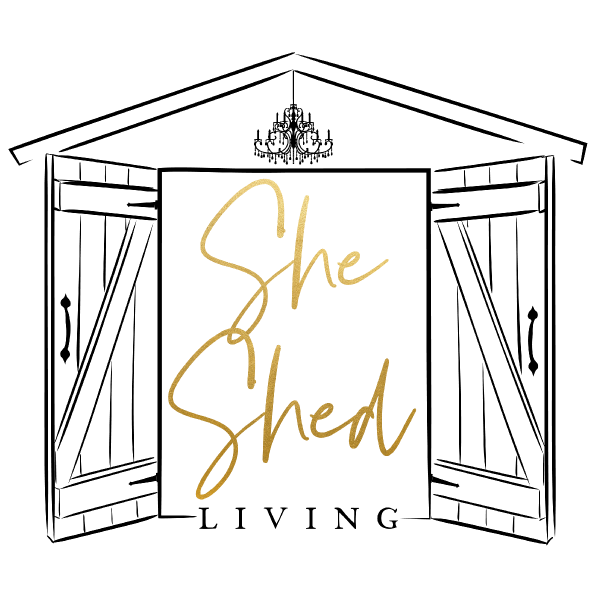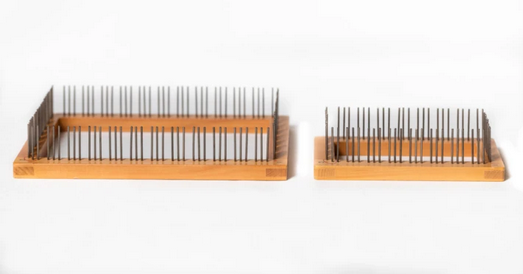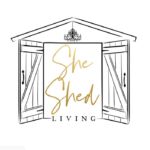Martha Knake’s she shed is the very picture of cozy and stylish outdoor living. You can see her on Instagram as she plays with design and various home and garden products to keep her private space fresh and fun.
Her mother Holly Janssen quietly watched her daughter, noting her simple delight in hanging out at the shed. So she decided to create a small replica of the place.
We’re talking SMALL.

Can you see it back there in the corner? Holly built a one-inch scale version of Martha’s backyard she shed. The original shed has a rich family history and is oh-so-worthy of reproduction; Martha’s father built it originally in the 90s as a playhouse for Martha’s two daughters. In 2017, when the girls had long outgrown the playhouse, Martha converted it into her own backyard escape.
Holly watched her husband back then, as he created that little structure for their grandchildren. “Her dad built the original and I built the mini, so now (Martha) has one from both of us,” she explains.

The Big World of Miniatures
The world of miniatures is fascinating, varied and vast. Consider miniaturist Kate Esme Unver, who has been collecting miniatures nearly her entire life. She launched an Instagram site in 2012 with a daily image of potted plants, food, furniture and handbags. Now she has more than 200,000 followers and published a book called The Book of Mini. There are miniature builders, makers, collectors, social media curators and seemingly millions of enthusiasts. Interior designers create rooms using 3D printers and then experiment with cabinetry, rugs and hardware before launching the real thing with their clients.
A recent NYT article says that searches for miniature furniture were up nearly 40% in the latter part of 2020, while the hashtag #miniature on Instagram contains 4.3 million posts and counting.
How to Make a Miniature She Shed
Holly started her miniature with a kit. The structure resembled Martha’s somewhat tall and narrow shed but needed a bit of modification. Her husband cut a new facade to match the shed. He also extended the roof so that it created a cover for the front porch. Then they added the four front porch posts, which are a defining feature of Martha’s shed. Holly used upholstery fabric glue and wood glue to attach the siding.

One possible source for kits and miniature furnishings is Real Good Toys. The company offers lots of different structures but the one that resembles a she shed the most is their Mouse House. The furnishings are lovely but a bit pricey. Try craigslist, etsy and ebay for used doll furniture — you’ll get a much better deal. Also, you can create a shed using a shoe box or cigar box with a bit of ingenuity.
Holly was eager to start the inside. She kept the walls down until she could whitewash the interiors and add mini wall studs using small wood strips. Then she began assembling her furnishings, textiles and decorative objects.
Main furnishings included a couch/daybed, a pink pouf, desk chair and a stepstool. Already a member of a miniature club, Holly had a collection of items to work from. She found a couch of the correct size but it needed different “upholstery.” A vintage handkerchief with cutwork edging fit perfectly after she added a bit of padding.
Holly had a vintage doily in her collection that she never could part with … until now. It found a new home as the pouf upholstery. The pink and white coloring is a little different from the actual pouf but “it adds a touch from Mom,” she says.

From there, Holly moved on to the desk. The desk itself was easy but the chair was a bit more work, as Holly wanted to capture the multi-layered paint of the old farm chair in Martha’s actual shed. She used yellow and blue paint, then covered it all with white enamel. Then she distressed the finish so a bit of the other colors peeped out.
The Tiny Details
The little shed was clearly a Christmas present. Look closely at the interior and what to your wondering eyes should appear but a miniature gingerbread house, a microscopic plate of decorated cookies, wee wrapped packages and much more. “The inside was the most fun,” Holly admits.
Pillows collected from her club friends were scattered about on the couch. Holly made her own throw for the back of the couch, using a Weave-it loom. (Side note: These portable little looms were very popular from the 30s through the 60s. The design was revived and produced by Weavettes and is still available today.)
The “Come as You Are” welcome mat had the perfect message but needed to be trimmed down a bit. Arranging these mini interiors involves trial and error, experimentation and most important, enjoying the hunt for just the right piece.
After placing a few lamps, a “Welcome” wall sign, a pair of fuzzy slippers and some string lights, the little shed was ready to go. Holly always finishes her minis with a little dog — you can glimpse his little nose behind the porch post.

Tips for Mini Shed Making
Holly’s been a miniature maker for many years and has learned a few tricks along the way. Here is her advice for those wanting to create a mini shed:
- Be patient. Keep telling yourself “this is fun” and walk away for a bit if it’s not. Glue not working? Try a different glue.
- Best tools: dental picks, X-Acto Knife, miter box
- To display your miniature and keep it dust-free, use a basketball display case like this one
- Best adhesives: Tacky for general purpose, YES for paper and E6000 silicone glue for everything else (Holly doesn’t recommend hot glue; it’s too hard to control)
- Got the bug? Join a group! Search for one on the National Association of Miniature Enthusiasts’ website.
Show us your miniature handiwork! Leave a comment below or send a photo via Instagram to @sheshedliving. We’ll give it a BIG shoutout.





Leave a Reply